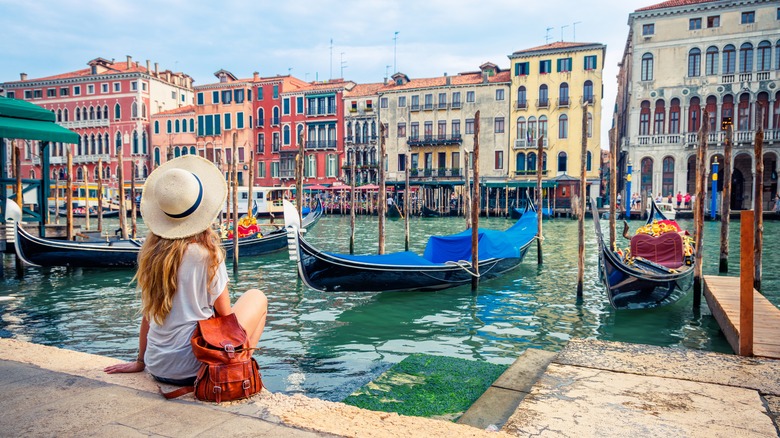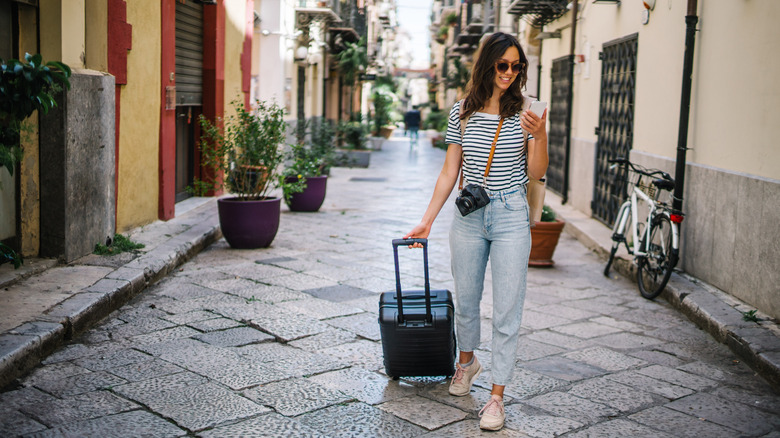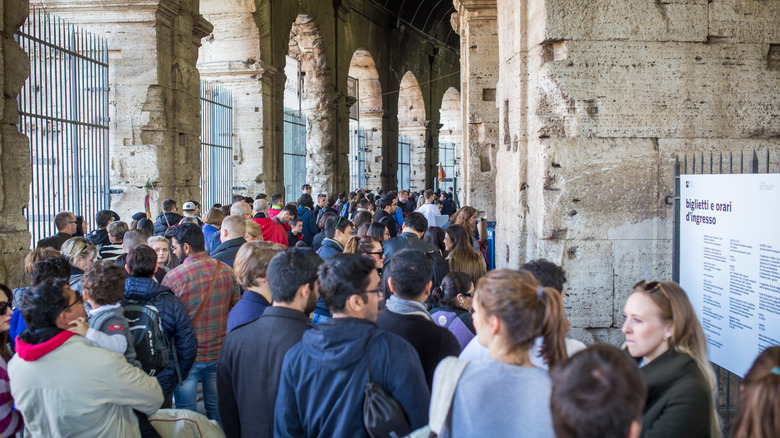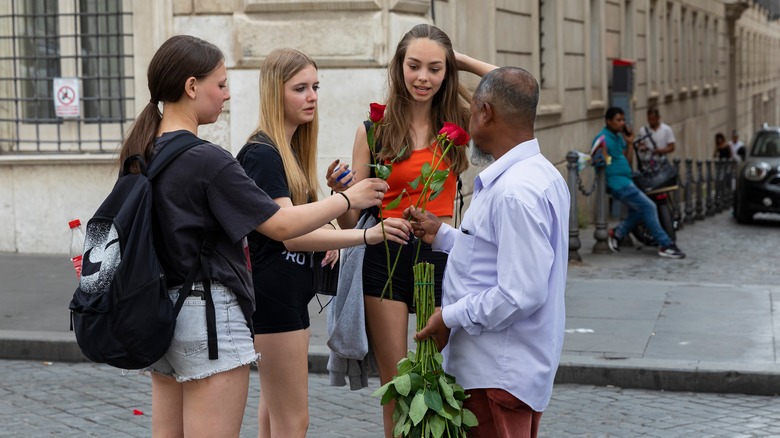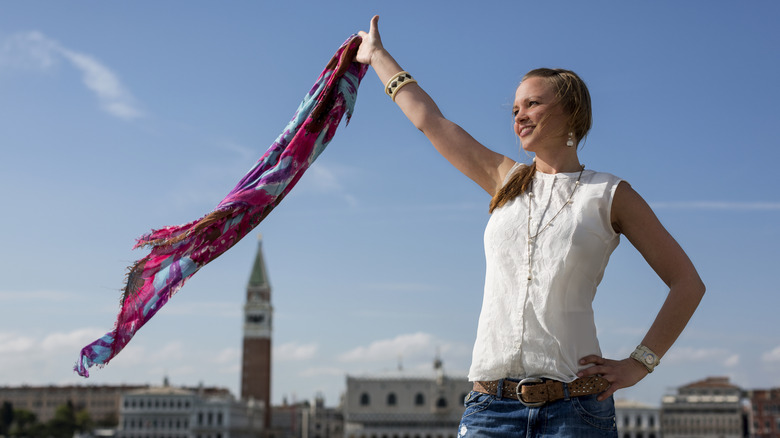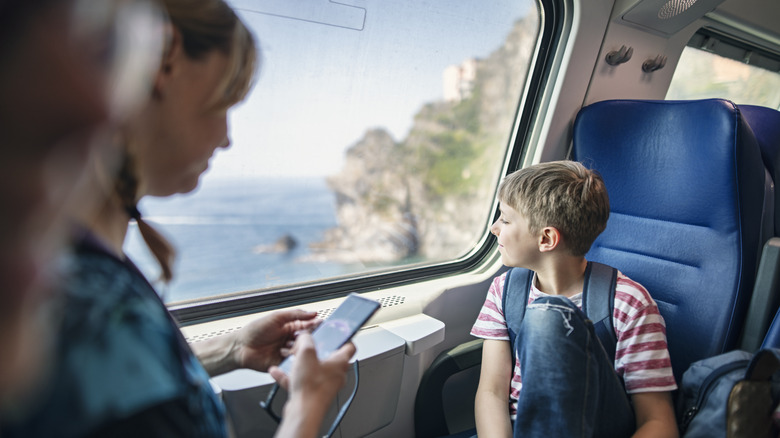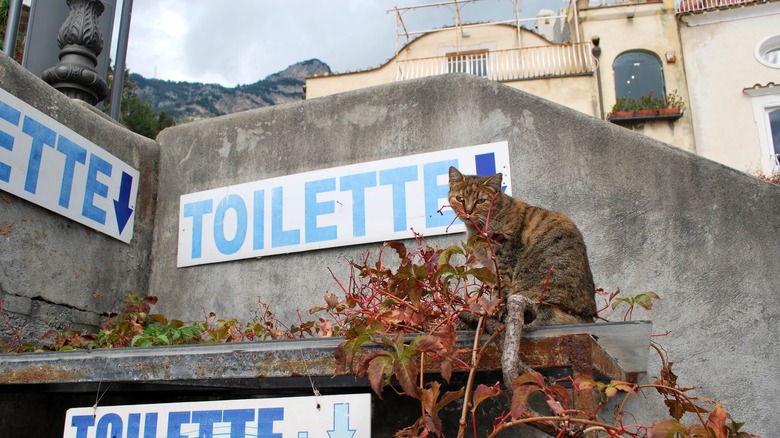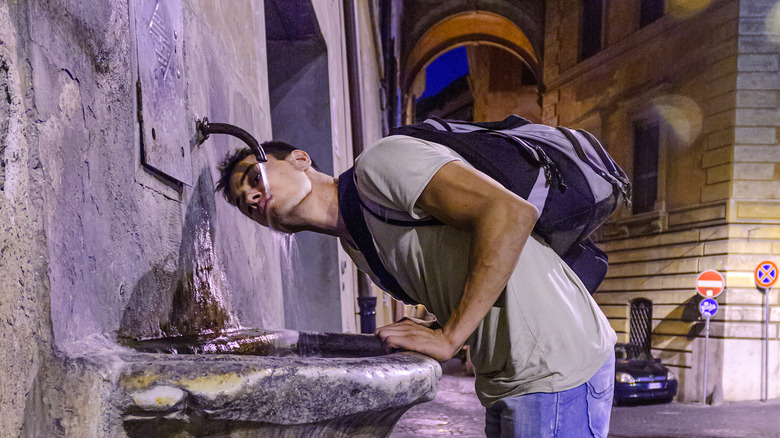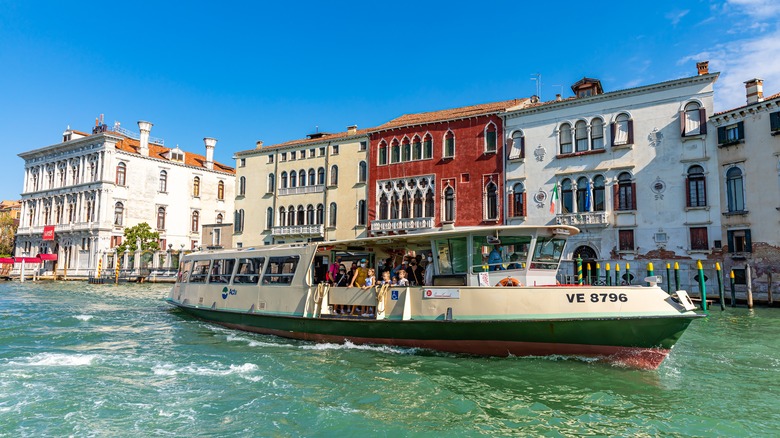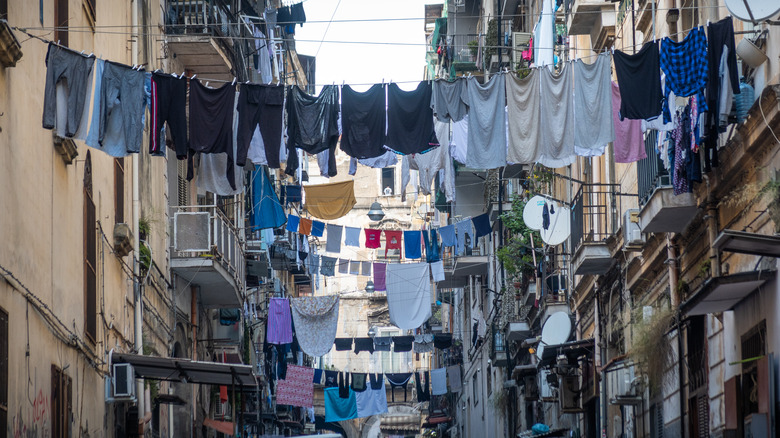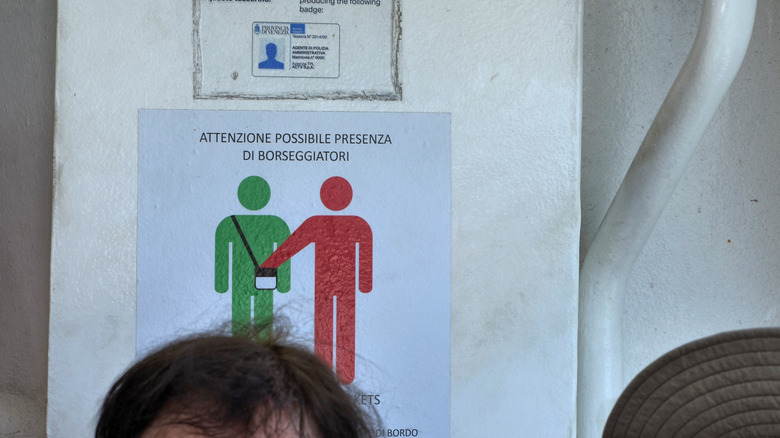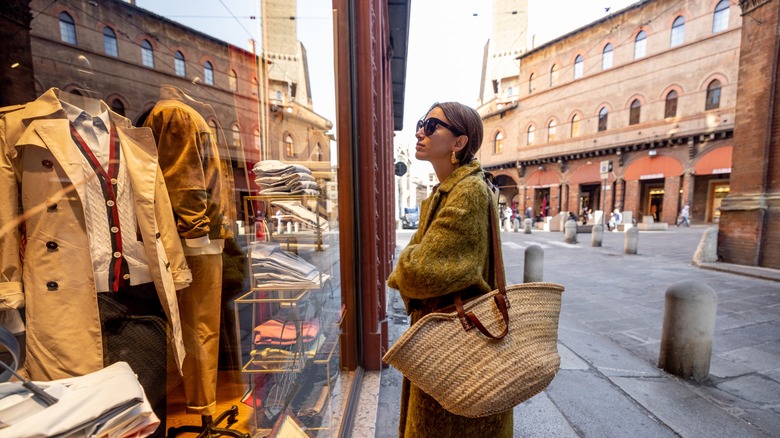Top-Tier Hacks Tourists Will Need To Know For A Vacation To Italy
Italy stands out among the world's most desirable travel destinations for many good reasons — from its sundry sea coasts stretching thousands of miles and its iconic historic attractions to its unique culture boasting gorgeous art, inimitable style, and incredible cuisine. It's impossible to experience everything that this peninsular nation has to offer within one lifetime, let alone one vacation.
Fortunately, following millennia of hosting foreign visitors from near and far, modern-day Italy boasts ample tourism infrastructure that allows almost anyone to delight in the country's diverse appeal. But that doesn't mean roaming around Italy is always easy. Local customs, laws, and societal quirks can cause confusion for sightseers from anywhere, oftentimes leading to disappointing travel ordeals that incur increased costs and marred memories.
We have had the pleasure of experiencing la dolce vita in Italy during numerous adventurous visits spanning must-see cities and rustic countryside expanses. While we treasure recollections of exploring Bologna's colorful porticos, picking cherries while sipping wine on a Tuscan hillside, and exploring the rocky shores of Northern Sardinia for seven days, these pleasant flashbacks are punctuated by plenty of travel traumas that taught us of the difficulties inherent to touring Italy. Avoid common mistakes and maximize your Italian escapades with these simple hacks, which will help you look back on your own time there with more amore.
Pack light, but plan from toe to head
This hack is a bit hackneyed, but among places where you won't regret traveling light, Italy ranks highly. First of all, the country's geography leans diagonal. Rome is famously built atop seven hills, and the count of mounts only rises beyond Italy's capital. The steep shores of Cinque Terre look amazing on a postcard, but lugging overstuffed luggage up those slopes will leave you too winded to enjoy the breathtaking vistas.
Furthermore, Italy's cobblestoned streets can make pulling wheeled suitcases more of a struggle than carrying them — so even if you're only visiting cities and towns, you're best off keeping your load low. Of course, you'll need a bundle of warm clothing if taking a January ski vacation in the Italian Alps, but when exploring sunbaked Sicily during summertime, less is more when it comes to clothes.
However, avoid one of the common clothing mistakes on a trip to Europe by bringing comfy shoes, even if they aren't your most fashionable footwear; competing with Italians on style is a futile exercise. Another must-bring item is a hat that folds to fit in a pocket or purse — sun protection is paramount in Italy. However, some attractions don't allow hats to be worn indoors, and carrying bulky headgear can detract from art appreciation.
Remember that all roads lead from Rome
Italy's different regions offer drastically disparate landscapes and attractions, from the watery architectural wonders of Venice to the Renaissance masterpieces of Florence to the beachy hideaway of Sorrento. All of these places can be easily reached by starting your journey in Rome. Traveling to Italy without visiting Rome would be a lost opportunity — you don't want to miss out on the Eternal City's timeless sights, and this is the best place to kick off a vacation around Italy, as well.
Rome has two major air hubs. Rome-Fiumicino Leonardo da Vinci International Airport (FCO) — serving direct flights from several U.S.-based airlines — and Ciampino Airport (CIA), hosting budget airlines traversing Italy and Europe. This convenient duo of airports make it easy to arrive in Rome from afar, spend a few days, and subsequently fly nationwide or to nearby countries.
Additionally, Italy's far-reaching rail network is centered in Rome. This includes high-speed express trains to several cities and regional lines, taking passengers off the beaten path daily. Beyond evoking romantic visions from a bygone era of Italian grand tours beginning at Rome's Termini railway station, taking the train is an eco-friendly way to travel.
Think ahead to buy tickets for major attractions
You'll surely enjoy admiring the intricate façades of Italy's landmark buildings, such as Rome's Colosseum or the Doge's Palace in Venice. This is true unless you're broiling in the sun for an extended period while in a long line for tickets to get inside. Fortunately, you can avoid this fate, even when visiting during peak tourism times.
The most proactive approach is to buy tickets for major attractions online in advance, preferably before your vacation begins — but do a little homework to arrange your visit through the official homepage for each monumental site, as passes provided by private agencies are often overpriced. This limits the flexibility of your itinerary, but you'll save time and money.
However, if you find yourself at an Italian landmark building with no ticket to get in, you may still avoid the longest lines by finding an affiliated attraction. For example, in Rome, a single ticket provides access to both the Colosseum and the lesser-known Palatine archaeological area. There is a ticket office right at the Colosseum and another ticket office a short stroll away at the Palatine entrance — guess which one almost always has shorter lines?
Give scammers the thumbs down
Many years ago, when people-watching by the Colosseum, we saw a sad scene unfold. Dressed in a gladiator costume (complete with a sword), a burly man roamed among the tourist hordes. Spotting a family taking photos by the ancient landmark, the "gladiator" joined them for a selfie — and then demanded money from the father. An offer of coins was angrily refused as the costumed ruffian forcefully demanded euro bills. We'll never forget the humiliated look on the father's face as he forked over a wad of cash.
Since then, Rome's authorities have cracked down on this extortion scam. However, more of these costumed criminals reportedly resurfaced in the same spot only a couple of years ago. If you happen to see such "gladiators" when you're there, put your camera away and don't even acknowledge them.
Unfortunately, these easily identifiable crooks are not the only scammers that prey on visitors in Rome and nationwide. Avoid accepting "free" flowers in Italy — if you take them, insistent requests for money will follow, and this also applies to so-called friendship bracelets that are tied to tourists' wrists before they realize what's happening. Keep your wits about you and keep on moving; these scammers are anything but friends.
Enjoy a gourmet pizza picnic, but not just anywhere
Originally created in Naples, pizza is a globally revered delicacy, and devouring it is a satisfying highlight of visiting Italy. After all, in the land where pizza was born, gobbling up slices counts as a cultural activity. What's more, pizza sold to-go at many hole-in-the-wall shops will taste better than pies offered for much higher prices at tourist-trap restaurants.
Italy's authentic takeout pizzerias — identified by signs stating "pizza al taglio" ("pizza by the slice") — sell this specialty by weight, not in pre-cut triangles. Sheets of this famous flatbread are typically sliced into rectangles with scissors, according to how much of it each customer craves. At the counter, you can choose various pizza types, using your hands to pantomime how large you'd like each slice to be. The goods are wrapped in paper, so you can take these fresh slices for an impromptu gourmet picnic. However, choose your alfresco-meal site carefully because Italian laws prohibit eating in public at landmark locales like St. Mark's Square in Venice, the Uffizi Gallery courtyard in Florence, and the Trevi Fountain in Rome (strict rules tourists need to know before visiting).
Carry a summer scarf for covering shoulders and more
No matter how hot it is outside when visiting historic churches in Italy, inside, you'll need to abide by dress codes requiring covered shoulders and knees. If they're long enough, dresses, capris, and baggy shorts are acceptable. For the torso, a simple T-shirt will usually work, but anyone wearing a tank top won't get in, and bared bellies may be barred, too.
If you prefer traveling in a shirt that shows too much skin for a higher power to handle, one way to skirt these rules is by bringing a light (but not transparent) summer scarf that can cover your shoulders during your visit. This should satisfy the dress code requirements; even in the strict Vatican Museums — where women are prohibited from baring their arms — the rules explicitly state that a shoulder cover may be worn during visits.
Depending on the durability of your chosen fabric, this summer scarf can be useful in myriad other ways while journeying in Italy. If it's light-colored, your scarf can provide sun protection, and it can also be used as an evening shawl, a beach blanket, a seat cushion, or even a theft-deterring device if strategically tied around a purse.
Travel by train, but know the system
Driving in Italy can be a stressful succession of traffic jams, parking pandemonium, and unpredictable streams of scooters. A lot of Italy's slender roads were designed long before the invention of motor vehicles, and they may have worked well for sandal traffic and livestock, but steering a car along them today can end in a game of chicken against an angry local laying on the horn.
If you really need to rent a car — like for visiting national parks or remote Tuscan wineries — then learn how not to look like a tourist when driving in Italy, and you'll get the hang of it soon enough and probably pick up some Italian curse words in the process. But if you're only traveling to cities and towns, do yourself a favor and take the train.
Some of our favorite memories of exploring Italy involve gazing from train windows passing coastal scenery, ancient Roman aqueducts, and towering campaniles. However, study up on ticketing procedures before stepping aboard. If you're using a multi-day rail pass or a regional train, you must validate your ticket at the station before the train departs, or a conductor may fine you even though you paid your fare.
Save your coins for public restrooms
Don't throw all of your spare change into Trevi Fountain — when nature calls, you may find yourself regretting it. Many public restrooms in Italy require a payment that typically ranges from €0.50 to €1.00, and an attendant will quite likely be guarding the door to collect it.
Italy's public restrooms are generally clean, but they might still hold unpleasant surprises. Many toilets have no seat, or you might even stumble upon a dreaded squat toilet that is essentially a hole in the floor. Also, the stall may not contain toilet paper — the aforementioned attendant probably has some, so make sure to request it before going in or just carry tissues wherever you travel.
If all this has you thinking that Italian public restrooms are best avoided, one way to get around visiting them is to stop by a coffee bar and make any purchase, which entitles you to use the establishment's toilet — but consider taking a quick look inside the facilities first to gauge their cleanliness. A safer bet is buying a coffee at a nice hotel, which will be more expensive, but depending on your needs, this could be well worthwhile.
Use Italy's drinking fountains
Proper hydration is important wherever you go, and this is especially true in Italy, with its many regions that are frequently hot and arid. Fortunately, local leaders started working to provide free water for everyone a long time ago. Actually, well over 2,000 years ago, when ancient Romans constructed incredible aqueduct systems that still supply communities today. In the same spirit, Italian cities and towns feature statuesque stone or metal public drinking fountains. It is perfectly fine to use them for filling up water containers — saving you the expense and eco-guilt of buying bottle after bottle — or drinking directly from the spouts.
However, not every fountain that you encounter in Italy is designed for drinking; it is unwise (and likely illegal) to try taking a sip from cascading landmarks that were obviously built only to be seen. Having trouble discerning whether a fanciful fount is for drinking? Hang out for a minute or two — a local will likely stop by and take a gulp, indicating that you're good to do the same.
Take the vaporetti to get around Venice like the locals
If you've long dreamed of drifting around Venice in a sleek gondola, then go ahead and check off that bucket list. Just be aware that this isn't the same as hailing a taxi; most gondolas only provide scenic jaunts that begin and end at the same spot. For a private ride, you'll probably be paying around €100 for a half-hour voyage.
Gondolas started out as public transportation, but nowadays, they're a tourist attraction. This doesn't mean you should expect tour-guide commentary from your gondolier, let alone an open-air opera recital. Their job is only to navigate the often chaotic waterway traffic, and it's best not to distract them from it. This especially applies to traghetto gondolas, which exist solely to carry passengers across the Grand Canal — a ride that can be had for only a couple of euros but lasts for just a few minutes.
However, if you want to see more of Venice from a sea-level perspective, join locals aboard the vaporetti — ferryboats that serve as public buses along multiple waterway routes within and around the city. A 24-hour pass to use all vaporetti lines currently costs €25, allowing you to see much more of the city (as well as neighboring islands like Murano and the Lido) for a fraction of what it costs for a quick gondola ride.
Plan your laundry needs down the line
Many picturesque Italian alleyways are crisscrossed by clotheslines. This scenery looks lovely as an Instagram backdrop, but it also reveals a fact of life in Italy that can confound visitors: Clothes dryers are a rare appliance there. From an eco-conscious point of view, this is good, especially since Italy's climate can naturally dry an entire load of laundry within a few hours. But it's important to note that self-service laundromats (called "lavanderia") are typically only found in major cities like Rome and Milan — so if you'll be visiting an Italian metropolis midway through your trip, make sure to add a lavanderia visit to your itinerary.
If you are staying in a home or apartment for a few days, it may very well be equipped with a washing machine but no dryer. In this case, by all means, wash your clothes there and hang them. However, make sure to do so early enough in your stay so that your duds have enough time to dry, as a rainy spell or cold snap can slow down the process.
Memorize go-to coffee orders before you go
Italians consider coffee as more of a potable art form than a simple source of caffeine. As such, different coffee drinks have distinct names — and if you'd rather avoid a game of beverage-related charades with an exasperated barista, learn how to order your preferred coffee drinks before you arrive. Keep in mind that local coffee hangouts usually bear a sign stating "bar." These establishments often serve alcohol, but their main purpose is to provide customers with fresh espresso. Generally, orders are taken at the register, and you're expected to pay before taking the receipt to the barista who makes your drink, so don't toss that precious scrap of paper.
What to order? Say "caffè," and you'll get a simple shot of espresso. Request a cappuccino if you like milk in your coffee, but only until around 11 a.m.; this is strictly considered as a breakfast beverage. A caffè macchiato is another blend of espresso with milk, which can be ordered anytime without raising eyebrows. But think twice before asking for an Americano — that's actually just watered-down espresso, not filter coffee, and ordering it immediately marks you as a tourist.
Artfully dodge pickpockets and bag thieves
With so many eye-catching sights constantly overwhelming the attention of visitors, Italy's cities are a pickpocket's dream. Indeed, Italy is one of Europe's most likely places to be pickpocketed, and the perpetrators are highly skilled — they often work in teams, and child-labor laws don't apply to this underworld industry.
On a long-ago family trip in Rome, a small kid approached our colleague's mother and took her hand in an apparent request for some spare change; meanwhile, another youngster had his hand in her pocket. While we managed to thwart this theft attempt, many other such schemes succeed in Italy every day, so before you go, make sure to learn all the hacks that will protect you from pickpockets while traveling.
Another incident that we witnessed during a night out in Naples was even more brazen. A pair of young men on a scooter slowed down while passing a woman wearing a chic purse over one shoulder, and then the passenger snatched her bag as the driver sped up, leaving her helplessly cursing as the two-wheeled wrongdoers disappeared. Avoid this fate by wearing a cross-body bag with a sturdy strap.
Shop for new clothes to wear immediately
Here's a great way to simultaneously travel light, minimize laundry needs, and acquire stylish new clothes in the process. Make a point of packing as little as possible, prioritizing necessities like undergarments and a handful of versatile outfits to wear during the initial days of your trip, and shop for fresh attire before gallivanting around Italy dressed in wearable souvenirs.
Italy has no shortage of places to buy fashionable threads at reasonable prices, so instead of carting a bunch of your old clothes across the ocean and back, simply shop for new apparel as needed on the go. Of course, if you're attending Fashion Week in Milan and need to be dressed to the nines, taking this approach won't be cheap — but at the other end of the spectrum, much of Italy's secondhand clothing will make you look super sophisticated when wearing it back home.
